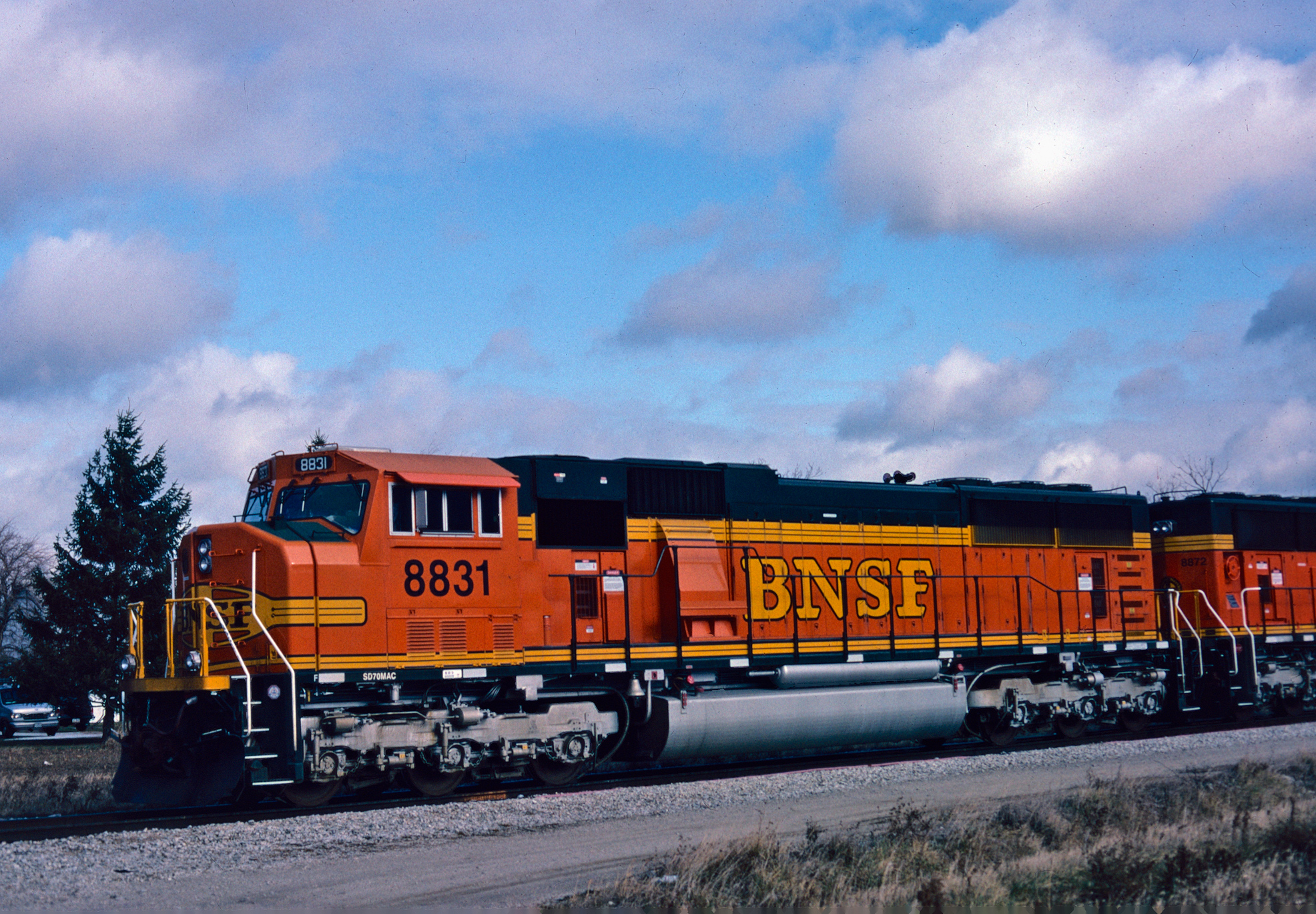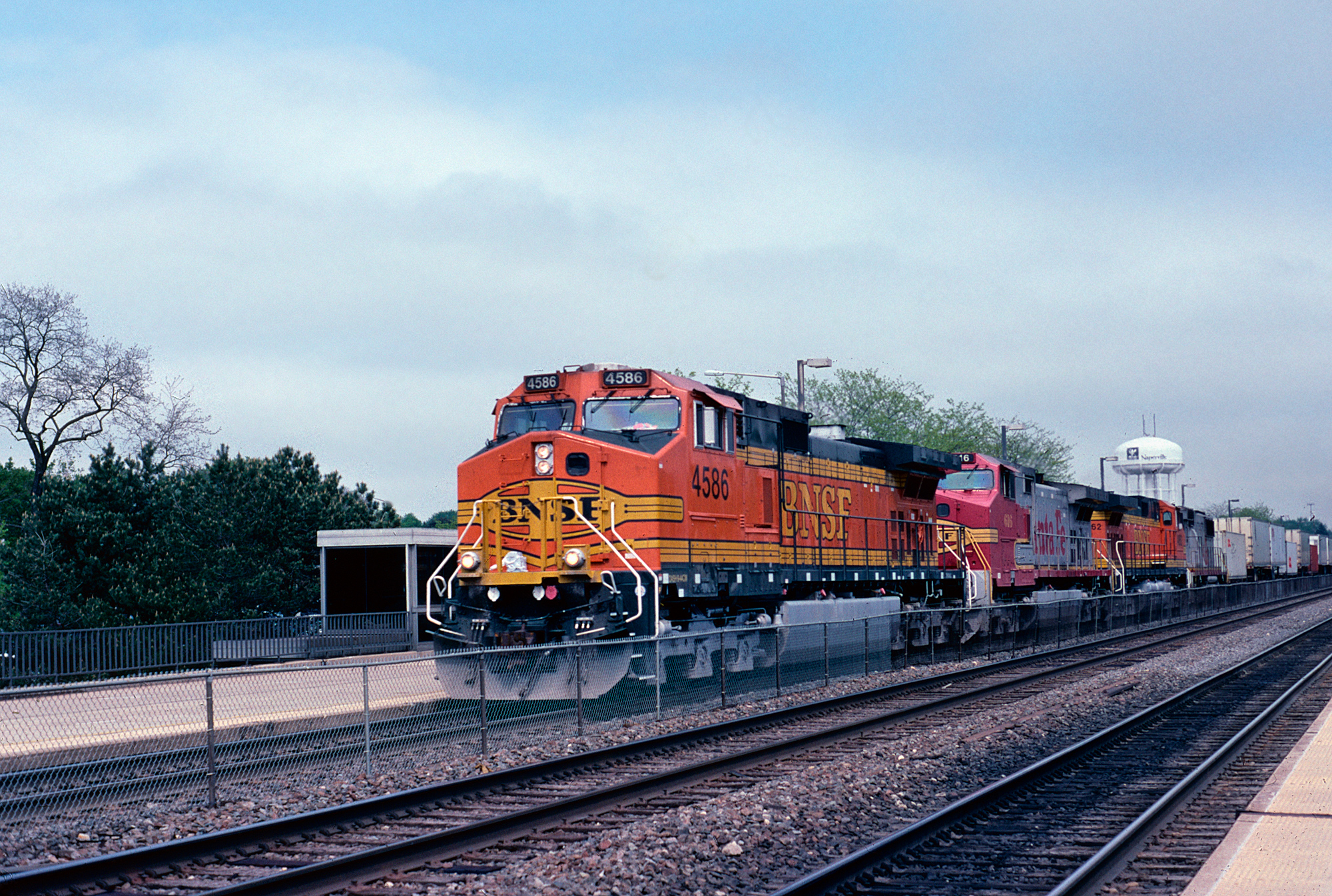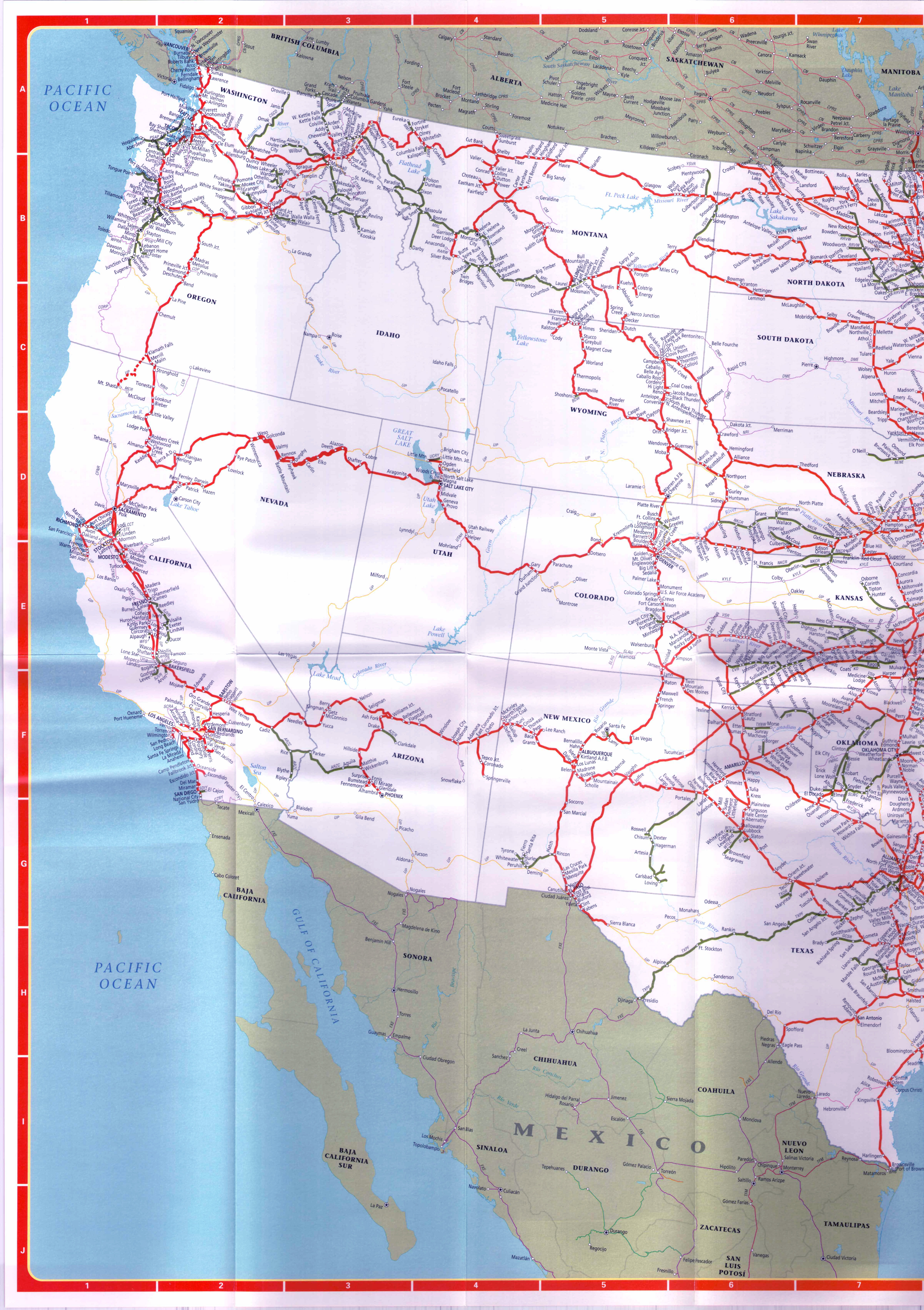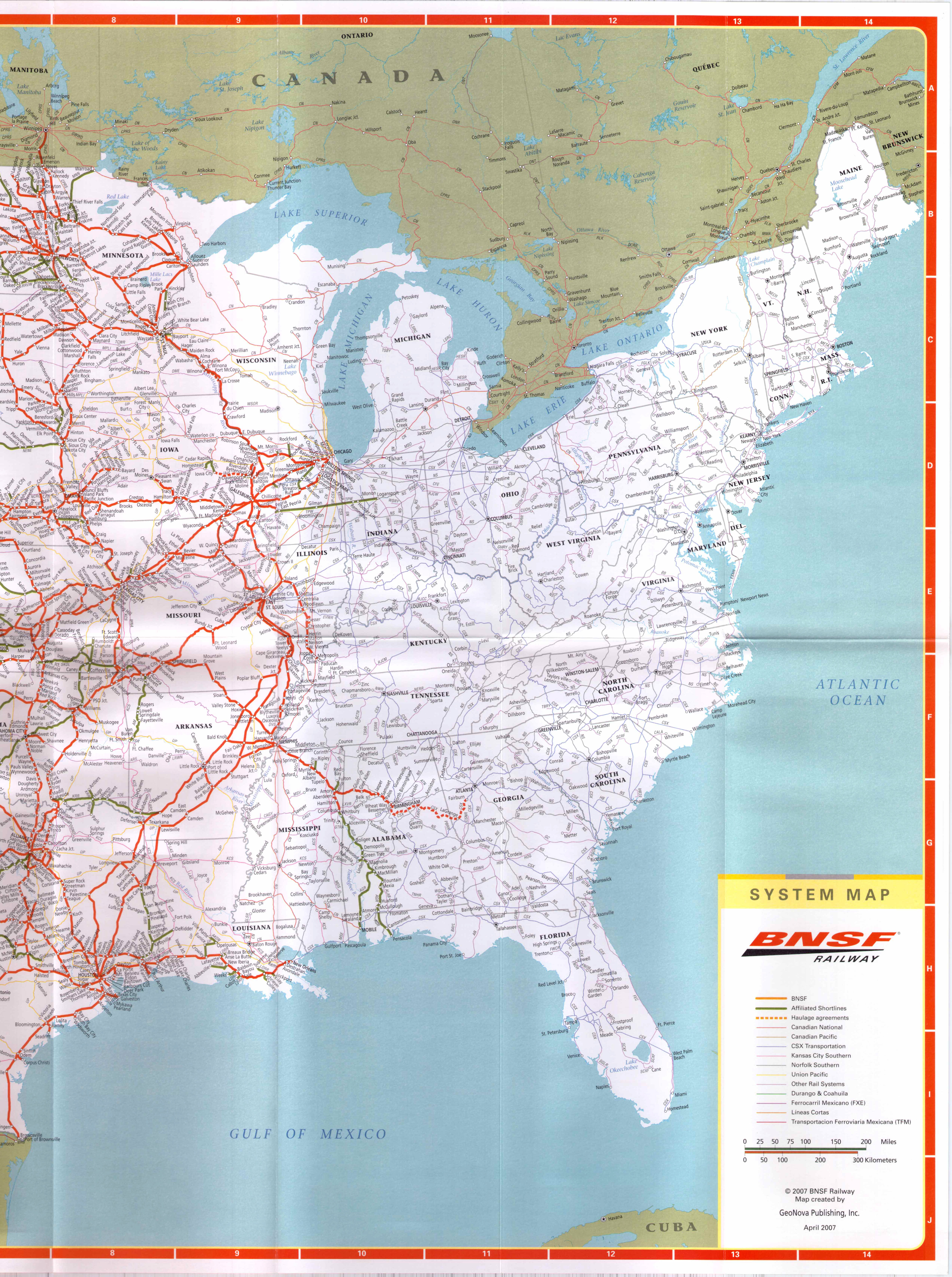BNSF Railway: Map, Logo, Owner, History
Last revised: August 30, 2024
By: Adam Burns
Like all of today's Class Is, the current BNSF Railway system was formed through a series of mergers and acquisitions that actually began over 40 years ago in 1970.
Today the railroad, like the two that came to form it, is a highly respected and recognized transportation company that consistently ranks at the top of the industry in terms of both quality of service and revenues earned.
In late 2009 Warren Buffett's Berkshire Hathaway announced plans to acquire a majority stock ownership in BNSF, essentially making the railroad a privately-owned corporation (a rarity in the industry where most large systems are publicly traded).
Within the current industry, BNSF battles with western rival Union Pacific for top honors of in annual revenue.
The two giants earn nearly twice as much as the next three Class I's (CSX, Canadian National, and Norfolk Southern).
Today, BNSF operates a 32,500 route mile system across 28 states (largely west of the Mississippi with some trackage into the Southeast) while employing more than 48,000.
The railroad also maintains a fleet of over 6,000 locomotives. Its annual revenue of $23.133 billion (as of 2019) makes it the top earning railroad in the industry.
Photos
 Burlington Northern Santa Fe SD70MAC #8831, only a few months old in this scene, heads west through Oregon, Illinois during December, 1999. American-Rails.com collection.
Burlington Northern Santa Fe SD70MAC #8831, only a few months old in this scene, heads west through Oregon, Illinois during December, 1999. American-Rails.com collection.History
For years the founder of the Great Northern Railroad, James J. Hill, tried to merge the GN with several other systems under his control which included:
- Northern Pacific (NP)
- Chicago, Burlington & Quincy (CB&Q, controlled by the GN)
- Spokane, Portland & Seattle (SP&S, jointly controlled by the GN/NP)
The GN and NP served nearly all of the major markets in the Northern Plains and Pacific Northwest while the Burlington linked Chicago with Minneapolis and stretched across the Midwest to Denver, Kansas City, St. Louis, and Houston, in conjunction with affiliates Fort Worth & Denver and Colorado & Southern.
Logo
In 1950 each road carried the following trackage: Burlington - 11,000 miles (including subsidiaries); Great Northern - 8,220 miles; Northern Pacific - 6,682 miles; and Spokane, Portland & Seattle - 968 miles.
According to Mike Schafer's, "Classic American Railroads," Hill had twice attempted to join the four, first in 1904 and later in 1927.
Due to fierce complaints from other carriers, citing the monopolistic nature of the merger, the Interstate Commerce Commission (the regulatory agency then overseeing such matters) declined the union.
During the mid-1960s the idea once again gained traction, although the ICC again turned down the proposal in 1966.
The railroads' leaders, however, did not give up and fix the issues, notably their own unions and rival Milwaukee Road, which maintained the only true transcontinental route from Chicago to the Pacific Northwest.
To do this the new railroad planned to keep its current facilities open so that most employees would still have a job while eleven new interchange gateways were provided to the Milwaukee along its main line west of Minneapolis.
In Mike Schafer's, "More Classic American Railroads," the next merger date was set for May 10, 1968 but again it failed, this time blocked by the Supreme Court.
Finally, after two additional years of discussions the long-sought merger was made official on March 2, 1970 forming the enormous Burlington Northern Railroad.
The new "Green Giant" dwarfed all other railroads in the west at the time, operating a 27,000+ mile system by 1981.
In comparison, the Santa Fe and Milwaukee Road both owned networks only slightly over 10,000 miles while Union Pacific of that time maintained just under 10,000 miles.
The new conglomerate continued to maintain its headquarters in St. Paul, Minnesota (also the home offices of all four predecessors) until 1981 when it transferred to Seattle under a new holding company as Burlington Northern, Inc.
In 1980, BN grew even larger when it acquired the St. Louis-San Francisco Railway, the "Frisco," which owned a 4,000+ mile network from St. Louis and Kansas City to Dallas/Fort Worth, Memphis, and Pensacola, Florida.
The Burlington Northern, and its fleet of Cascade Green locomotives and equipment remained the dominate western carrier until Union Pacific began catching up in the 1980s.
Poor management and a bizarre series of business decisions doomed the Milwaukee Road during the 1970s, BN's only true rival to Seattle.
It entered bankruptcy in 1977, abandoned its [ironically] lucrative western extension in 1980, and later disappeared in 1985 when purchased by the Midwestern carrier Soo Line.
UP took a drastic opposite approach; it purchased the Missouri Pacific, Western Pacific, and Missouri-Kansas-Texas (Katy) during the 1980s. The 1990s saw the addition of the Chicago & North Western and Southern Pacific/Rio Grande.
These moves witnessed Union Pacific overtaking BN, briefly, as the largest railroad in the country (today, UP and successor BNSF battle for this title, each operating around a 32,000-mile network).
While UP was working to acquire the C&NW and SP/D&RGW, Burlington Northern entered talks with the Atchison, Topeka & Santa Fe about a possible merger, making the formal announcement on June 30, 1994.
The plan was approved by shareholders on February 7, 1995 and after Union Pacific dropped its appeal a month earlier the Interstate Commerce Commission approved the union on August 23, 1995.
From that point the process moved relatively quickly as the Burlington Northern Santa Fe Corporation was formed to acquire each railroad's holding company (Burlington Northern, Inc. and the Santa Fe Pacific Corporation), a process made official on September 22, 1995.
The last piece of the puzzle included the merging of the actual railroads; on December 31, 1996 Santa Fe and its iconic "Warbonnet" livery was dissolved into Burlington Northern, subsequently renamed as the Burlington Northern and Santa Fe Railway Company.
System Map (2007)
The company's long, drawn out name survived for another decade until it was officially shortened as the BNSF Railway on January 24, 2005.
The disappearance of the great Santa Fe system was a sad end for the industry. While the end of most privately operated passenger trains in 1971 had led to the general public to largely forget about railroads, the AT&SF endured as one of the famous companies in American history.
Its humble beginnings began in 1860 with the chartering of the Atchison & Topeka in 1859 to connect its namesake towns in New Mexico and Kansas.
After completing this endeavor and being renamed as the Atchison, Topeka & Santa Fe in 1863 the new railroad set about rapidly expanding across the West reaching Needles, California in 1883 and Los Angeles in 1887.
Through a subsidiary known as the California Southern Railroad it reached San Diego in 1885.
Predecessors
Atchison, Topeka & Santa Fe: A brief history of the Santa Fe has already been featured here but the road's importance to the American landscape and economy is quite incredible.
Its transcontinental main line was fast, efficient, thoroughfare for freight and passengers which remains under heavy used today by BNSF. In addition, it launched the legendary, all-Pullman Super Chief on May 12, 1936.
A year later, it was re-inaugurated on May 18, 1937 with lightweight equipment and streamlined diesels from Electro-Motive that bore a stunning livery by Leland Knickerbocker named the "Warbonnet."
The artist worked at General Motors' styling department, which designed many of the industry's now-classic liveries, and came up with the Santa Fe's scheme by playing on a Native American theme, using the head dress as the "bonnet" covering the nose and then sweeping down along the locomotive's bottom skirting.
This was featured in striking red while a Circle and Cross Native American design with "Santa Fe" adorned in yellow was displayed in the center.
As a final touch, an Indian head logo was featured on the center carbody. It was a marketing sensation while the services on-board rivaled the best across the country.
The Santa Fe went on to market an entire fleet of Chiefs including the original Chief, San Francisco Chief, and Texas Chief.
Throughout its history and the Santa Fe was a highly profitable railroad, allowing it maintain top-notch passenger service until Amtrak began in 1971.
Chicago, Burlington & Quincy: The third significant piece of the Burlington Northern puzzle was the CB&Q. It was also the largest, operating a system of roughly 11,000 miles.
The Burlington began as the small Aurora Branch Railroad, chartered in 1848. It opened for service on September 2, 1850 on six miles of track connecting Batavia, Illinois to Turner Junction.
In 1852 it was renamed as the Chicago & Aurora with new intentions of connecting these cities and operate an east-west route.
In 1855 the system was renamed as the Chicago, Burlington & Quincy and opened its initial main line from Aurora to Chicago in 1864.
The CB&Q spent the next half-century expanding across the Midwest reaching the Twin Cities, St. Louis, Kansas City, Omaha, Denver as well as parts of Wyoming and southeastern Montana.
It acquired the Colorado & Southern/Fort Worth & Denver City in 1908 which gave the railroad access to Denver, Fort Worth, and Galveston, Texas via Denver.
Historically, the road is well-remembered for operating the first diesel-powered streamliner trainset, the Zephyr 9900, in April of 1934.
Its success led to an entire fleet of Zephyrs across the Midwest, as well as the popular California Zephyr to California in conjunction with the Rio Grande and Western Pacific. The CB&Q was always a run operation with good leadership and strong management.
Great Northern: The GN was one of the three primary components of what later became 1970's Burlington Northern merger. It was the dream of tycoon James Hill, the "Empire Builder."
It all began when he acquired the St. Paul & Pacific in 1878, in conjunction with a group of businessmen.
A small system located in Minnesota, the StP&P held title as the first to operate a train its home state although it was having little success along a main line which stretched from St. Paul to St. Vincent near the Canadian border.
After Hill took control he formed the St. Paul, Minneapolis & Manitoba, purchasing the StP&P in 1879 and began pushing rails to the west.
It reached Great Falls, Montana in 1887 and Butte via the Montana Central. In 1889 he created the Great Northern Railway, which acquired control of his subsidiaries and continued its westward march.
In 1893 the GN finally reached Seattle, becoming the second transcontinental railroad to the Pacific Northwest.
At its peak size it operate more than 8,000 miles from the Twin Cities to Puget Sound while other important markets included Duluth, Fargo, Billings, Spokane, and Portland, Oregon via subsidiary Spokane, Portland & Seattle.
It operated one of the country's most popular long-distance trains, the Empire Builder, which is still in service under Amtrak today.
One of the industry's great engineering feats was built by the railroad, Cascade Tunnel, whose current bore is nearly 8 miles underground and remains in regular service.
 Burlington Northern Santa Fe C44-9W #4586, Santa Fe C44-9W #616, another BNSF C44-9W, and a Santa Fe GP60B lead trailers westbound past the station in Naperville, Illinois during April of 2002. American-Rais.com collection.
Burlington Northern Santa Fe C44-9W #4586, Santa Fe C44-9W #616, another BNSF C44-9W, and a Santa Fe GP60B lead trailers westbound past the station in Naperville, Illinois during April of 2002. American-Rais.com collection.Northern Pacific: The second significant element of Burlington Northern was the Northern Pacific, the first system to complete a transcontinental line to the Puget Sound.
With the signing of the second Pacific Railroad Act into law by President Abraham Lincoln on July 2, 1864 the Northern Pacific Railroad Company was created to build the first transcontinental railroad into the Pacific Northwest.
The groundbreaking to head west took place near Carlton, Minnesota on February 15, 1870 (25 miles west of Duluth) while crews also began laying grade east from Kalama, Washington Territory around the same time.
By 1873 the disconnected segments had linked Duluth with Bismarck, Dakota Territory and Kalama with Tacoma to the north.
However, that year, Jay Cooke's banking firm backing the project failed that year and the entire railroad seemed doomed.
In 1878 new ownership brought new life into the project and it held a golden spike ceremony at Gold Creek, Montana on September 8, 1883.
About a decade later it was joined by the Great Northern and both roads operated similar territory.
At its peak, the NP stretched more than 6,500 miles handling a variety of freight. It also fielded one of the industry's great trains, the North Coast Limited.
Today, a great deal of the NP has been sold or leased, notably its main line through Montana which is now operated by Montana Rail Link.
Spokane, Portland & Seattle: The SP&S was a long-held subsidiary of Northern Pacific and Great Northern.
It was originally chartered in 1905 (briefly referred to as the Portland & Seattle) to connect Spokane with the Pacific Coast via Portland, Oregon and the Columbia River.
In 1909 it had opened its 379 main line between the two cities although ironically never reached Seattle. At its peak the SP&S operated just under 1,000 miles running from Portland to the coast along the northwest corner of Oregon.
It also operated a long branch to Bend, Oregon (operated as part of the "Inside Gateway" in conjunction with the Great Northern and Western Pacific via Bieber, California) and connected Eugene, via Portland, thanks to its ownership of the Oregon Electric, a successful interurban.
St. Louis-San Francisco Railway: The Frisco was, geographically, the oddest component of the Burlington Northern located much further east than the others.
Its earliest ancestry traces back to the Pacific Railroad, a 1849 creation of the Missouri State Legislature. The PR had intentions of connecting to the Pacific Coast and it was later reorganized as the Missouri Pacific.
However, a separately chartered extension of its system known as the Southwest Branch of the Pacific Railroad was chartered in 1852 to connect with the PR main line at Franklin to Rolla, opening in 1860.
This segment was the earliest heritage of the later Frisco. In 1868 it was renamed as the South Pacific Railroad and had reached Pierce City, Missouri by 1870.
At the same time it the SPRR came under the control of the Atlantic & Pacific Railroad.
The A&P opened to Springfield and also set its sights on the Pacific Coast, forming the St. Louis & San Francisco Railway on September 7, 1876 for this very purpose.
Unfortunately, the road faced bitter resistance from other western roads to prevent it from reaching the coast and ultimately it reached no further west than Floydada, Texas.
After the financial Panic of 1893 it was reorganized as the St. Louis & San Francisco Railroad while another bankruptcy in 1913 saw its name changed again as the St. Louis-San Francisco Railway in 1916.
At its peak the Frisco reached 5,000 miles connecting St. Louis and Kansas City with Fort Worth and Dallas while another southerly extension pushed into Florida's Northern Panhandle.
Despite its financial problems of the years it was actually quite profitable at the time of its Burlington Northern acquisition.
The railroad spent the rest of the 19th century building eastward to the all-important rail hub of Chicago, Illinois, reaching the Windy City in 1888 becoming the only railroad with its only transcontinental route until the mega-mergers of the 1970s and 1980s.
Following this event the Santa opened a link to Denver and pushed rails into Texas connecting with Dallas and Fort Worth.
The AT&SF's greatest density of trackage was situated in Kansas, Texas, Oklahoma, and the Lone Star State where it operated hundreds of miles of secondary trackage.
The highly profitable railroad became a legendary figure of American commerce when it introduced its popular Super Chief streamliner in the 1930s.
The services, of course, were superb but the railroad’s beautiful Warbonnet livery, was the most famous paint scheme ever worn within the industry.
After its debut, variations remained in use by the company until its merger with Burlington Northern.
The Santa Fe, albeit no longer an operating company, is truly a railroad whose name is as common as that of Coca Cola or General Electric.
The Santa Fe was also a class act in transportation service and a highly respected company. Such attributes carry on today under BNSF.



